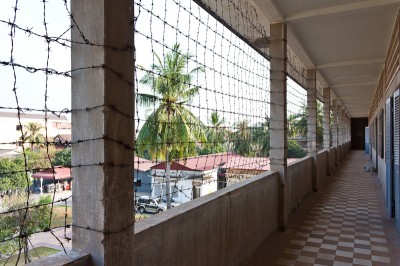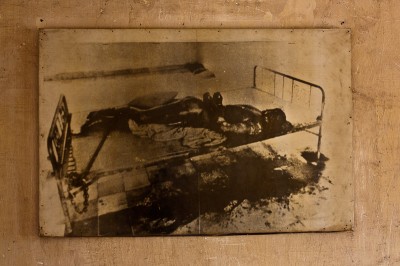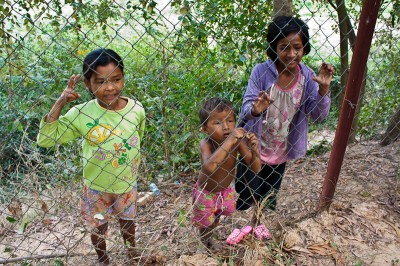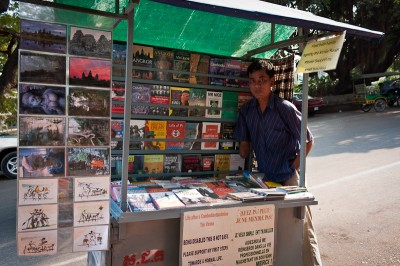On my bus from Vietnam to Cambodia, I started to read about the history of Cambodia in the “Lonely Planet” travel guide, and I was startled by what I read. The more I learned about Cambodia while traveling there, the more I was bewildered. Some unimaginably evil things happened in this country.
Here is a short summary of the most tragic parts of Cambodia’s recent history:
Between 1969 and 1973, American forces and Republic of Vietnam forces secretly began bombing and briefly invading Cambodia in their effort to fight the Vietnamese and Cambodian communist parties, the Viet Cong and the Khmer Rouge. Numbers of deaths caused by the bombings vary greatly from 200.000 – 300.000 to 600.000 – 800.000 casualties. According to the US. Airforce 16000 of the 25000 Khmer Rouge fighters, besieging Phnom Penh, were killed. But the great number of civilian casualties drove many more to the Khmer Rouge.
On 17 April 1975, two weeks before the fall of Saigon, the Khmer Rouge captured Phnom Penh. This was the end of 5 years of civil war in Cambodia and from 1975 to 1979, the Khmer Rouge, led by Pol Pot, was the ruling party in Cambodia. It was the darkest time in Cambodia’s history and probably one of the darkest times in the history of mankind. During this time, around one third of Cambodia’s eight million citizens died as a direct result of the policies of the Khmer Rouge.

The Khmer Rouge wanted to create a purely agrarian-based Communist society. All cities were completely evacuated and the whole population had to work in collective farms or forced labor projects. Schools, religious buildings, hospitals and anything considered western was destroyed. Any opponents, monks and intellectuals were systematically killed. Anyone who was somehow educated, who spoke a foreign language or who just wore glasses was killed. The Khmer Rouge believed parents were tainted with capitalism. Consequently, children were separated from parents and brainwashed to socialism as well as taught torture methods with animals. Children were a “dictorial instrument of the party” and were given leadership in torture and execution.
For example, a young girl who was trained as an executer, would pick random workers from the farms, tie them up and unhesitatingly kill them by putting a plastic bag over their head. Another standard killing method was to line the victims up in front of a mass grave and slaughtering them one by one with a machete. Even babies and pregnant women were killed or tortured to death in unthinkable ways.

At some point members of the Khmer Rouge even started to kill each other, because nobody could be trusted anymore. Eventually the Khmer Rouge started to kill people in villages in bordering Vietnam, whereupon Vietnamese troops invaded Cambodia in December 1978. In January 1979 the Vietnamese captured Phnom Penh and put an end to the brutal Khmer Rouge regime.
However, the Khmer Rouge maintained control in some regions and continued to fight on as guerillas. From that point on, the Khmer Rouge were supported by China, the USA and the ASEAN, who trained their fighters and supplied them with food, medicine and weapons. This kept the civil war alive, however the Khmer Rouge were always inferior to the occupying Vietnamese forces.
The chaos in the following years (millions set off on foot to find out if family members survived the apocalypse, wherefore the harvest was neglected) and the total economic sanctions by the US and its allies resulted in a famine killing hundreds of thousands more people.
In 1991 a peace accord was signed by all opposing parties, however part of the Khmer Rouge kept fighting their guerilla war and the last fighters surrendered not until 1998. Pol Pot died on 15 April 1998, having never been put on trial for his genocide.
Today, Cambodia is still one of the poorest countries in the world, which is only slowly recovering from its devastating past. Some people complain, that reckless capitalism and corruption are today’s problems in this country.
My feeling from walking the streets of Phnom Penh and Siem Reap is, that the contrast between poor and rich is very extreme here. The streets are filled with begging children on one side (40 percent of Cambodians are under the age of 15), where at the same time fancy and shiny cars are jamming the roads.

Apparently, Cambodia has had and still has a big sale going on. Even some of its holiest sights, like the temples in Angkor Wat (Entrance fee = 20 USD per day) and the Choeung Ek Killing Fields, were sold to private, and often foreign, companies. Many Cambodians, whose loved ones died at the Choeung Ek Killing Fields, were upset that it was sold to a Japanese company.
Ultimately tourism is growing in Cambodia and it is for many Cambodians the only chance for an income. As a tourist it is mostly likely that, despite their terrifying recent history, you will only meet very friendly and welcoming Cambodians.

Have a look at the galleries to see more pictures from the Choeung Ek Killing fields and the Tuolsleng genocide museum.
References:
Books:
Survival in the killing fields
Lonely Planet (travel guide)
Movies:
The killing fields
Internet:
http://en.wikipedia.org/wiki/Vietnam_War
http://en.wikipedia.org/wiki/Khmer_Rouge
http://en.wikipedia.org/wiki/Cambodia
http://www.thirdworldtraveler.com/American_Empire/Nixon_Cambodia_LFE.html
http://www.irrawaddy.org/article.php?art_id=2412
http://www.economist.com/node/3966394
http://news.bbc.co.uk/2/hi/asia-pacific/4415873.stm
Sure. Cambodia used to have a awful history.